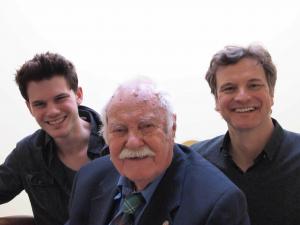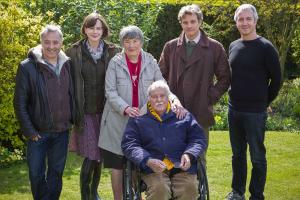Sometime the hating has to stop
 A film about the amazing life of Eric Lomax has just opened with Colin Firth playing the part of this terribly tortured World War II prisoner of the Japanese who turned a hated enemy into a friend. Lomax died in 2012 at the age of 93 and was a soldier who in the words of an article in the Daily Telegraph made 'the choice of reconciliation over retribution'. His experience indicates that there may be a time and season for forgiveness that sometimes cannot and should not be rushed.
A film about the amazing life of Eric Lomax has just opened with Colin Firth playing the part of this terribly tortured World War II prisoner of the Japanese who turned a hated enemy into a friend. Lomax died in 2012 at the age of 93 and was a soldier who in the words of an article in the Daily Telegraph made 'the choice of reconciliation over retribution'. His experience indicates that there may be a time and season for forgiveness that sometimes cannot and should not be rushed.
 In his award-winning book, The Railway Man, Lomax describes what happened when he was taken prisoner in Singapore when it fell to the Japanese. As a member of the Royal Corps of Signals, he had helped build an illicit radio, whose discovery brought on two years of torture and starvation, and then after the war many years of distress. It took him fifty years to reach the point that he could forgive.
In his award-winning book, The Railway Man, Lomax describes what happened when he was taken prisoner in Singapore when it fell to the Japanese. As a member of the Royal Corps of Signals, he had helped build an illicit radio, whose discovery brought on two years of torture and starvation, and then after the war many years of distress. It took him fifty years to reach the point that he could forgive.
I tell the Lomax story in Forgiveness: Breaking the Chain of Hate:
For many years after the war, Lomax allowed his professional life to crowd out his desire to settle old accounts with those who had tortured him at Kanburi. But 25 years after the war, when he had retired, the desire to know more about what had happened became more intense than ever. 'I had to admit that I wanted to make them pay, pay more than they had already done.' The more he thought about it, the more he wanted to do physical damage to the Japanese. 'Physical revenge seemed the only adequate recompense for the anger I carried.' The faces of the Japanese military police were with him every day. But the interpreter who had been present at all the torture sessions became his 'private obsession' and the focus of his hatred.
'Although I could not have admitted it,' he says, 'I was still fighting the war in all those years of peace.'
Then, in an extraordinary sequence of events, Lomax received news of that interpreter, Nagase Takashi, who had apparently devoted his life to charitable causes near Kanburi and had just built a Buddhist temple there. Lomax read about his activities, including the organizing of a meeting of reconciliation at the River Kwai bridge, with what he calls 'cold skepticism' and found the very thought of Nagase distasteful. 'I had not seen a Japanese since 1945 and had no wish ever to meet one again. His reconciliation assembly sounded to me like a fraudulent publicity stunt.'
 Lomax then encountered a new organization, the Medical Foundation for the Care of Victims of Torture. Like most former POWs, he had not contemplated meeting with psychiatrists or psychotherapists. The Medical Foundation was started by Helen Bamber, a nurse who entered Bergen-Belsen with the Allies at the age of 19 in 1945.
Lomax then encountered a new organization, the Medical Foundation for the Care of Victims of Torture. Like most former POWs, he had not contemplated meeting with psychiatrists or psychotherapists. The Medical Foundation was started by Helen Bamber, a nurse who entered Bergen-Belsen with the Allies at the age of 19 in 1945.
In 1989 Lomax was shown an article about the interpreter Nagase, who had devoted much of his life 'to making up for the Japanese Army's treatment of prisoners of war.' He was quoted as saying that he had decided to dedicate the rest of his life to the memory of those who died constructing the railroad. The article described his ill health, and how every time he had a cardiac arrest he had flashbacks of the Japanese military police torturing a POW who was accused of possessing a map of the railway. 'As a former member of the Japanese Army, I thought the agony was what I have to pay for our treatment of POWs.'
The POW described was Lomax. At last, Lomax had found one of his tormentors. The old feelings of revenge rose up, and he wanted to damage Nagase for his part in ruining his life. One or two people suggested that it was time to forgive and forget. 'I don't normally argue openly about anything, but I began to argue just a little about this. The majority of people who hand out advice about forgiveness have not gone through that sort of experience I had; I was not inclined to forgive, not yet, and probably never.'
Then Lomax read an account written by Nagase in which he expressed the belief that he was forgiven. Lomax's wife, Patti, with his agreement, wrote to Nagase expressing astonishment that he could feel forgiven when this man he had tortured had not forgiven him. It was the beginning of a moving exchange of letters which led eventually to their meeting in Kanburi.
Lomax describes the first encounter in these words:
He began a formal bow, his face working and agitated, the small figure barely reaching my shoulder. I stepped forward and took his hand and said, 'Ohayo gozaimasu, Nagase san, ogenki des ka?' 'Good morning, Mr Nagase, how are you?'
He looked up at me; he was trembling, in tears, saying over and over 'I am very, very sorry ...' I somehow took command, led him out of the terrible heat to a bench in the shade; I was comforting him, for he was really overcome. At that moment my capacity for reserve and self-control helped me to help him, murmuring reassurances as we sat down. It was as though I was protecting him from the force of the emotions shaking his frail-seeming body. I think I said something like 'That's very kind of you to say so' to his repeated expressions of sorrow.
He said to me 'Fifty years is a long time, but for me it is a time of suffering. I never forgot you, I remember your face, especially your eyes.' He looked deep into my eyes when he said this. His own face still looked like the one I remembered, rather fine-featured, with dark and slightly hidden eyes; his wide mouth was still noticeable beneath cheeks that had sunken inwards.
I told him that I could remember his very last words to me. He asked what they were and laughed when I said 'Keep your chin up.'
 He asked if he could touch my hand. My former interogator held my hand, which was so much larger than his, stroking it quite unselfconsciously. I didn't find it embarrassing. He gripped my wrist with both of his hands and told me that when I was being tortured — he used the word — he measured my pulse. I remembered he had written this in his memoir. Yet now that we were face to face, his grief seemed far more acute than mine. 'I was a member of Imperial Japanese Army; we treated your countrymen very, very badly.' 'We both survived,' I said encouragingly, really believing it now.
He asked if he could touch my hand. My former interogator held my hand, which was so much larger than his, stroking it quite unselfconsciously. I didn't find it embarrassing. He gripped my wrist with both of his hands and told me that when I was being tortured — he used the word — he measured my pulse. I remembered he had written this in his memoir. Yet now that we were face to face, his grief seemed far more acute than mine. 'I was a member of Imperial Japanese Army; we treated your countrymen very, very badly.' 'We both survived,' I said encouragingly, really believing it now.
A little later, I'm sure he said, 'For what purpose were you born in this world? I think I can die safely now.'
The two men had long conversations as they moved around the area. Lomax began to feel that his strange companion was a person who he would have been able to get on with long ago if they had met under other circumstances. They had much in common. But Lomax still had the matter of forgiveness to consider. A Thai woman had explained to him the importance of forgiveness in Buddhism:
I understood that whatever you do you get back in life and if what you have done is tainted with evil and you have not made atonement for it, evil is returned to you in the next life with interest. Nagase dreaded hell, and it seemed that our first meeting had made parts of both our lives hellish already. Even if I could not grasp the theology fully, I could no longer see the point of punishing Nagase by a refusal to reach out and forgive him ... the question was now one of choosing the right moment to say the words to him with the formality that the situation seemed to demand.
The two men flew to Japan. They went to Hiroshima, and Lomax and Patti laid a bunch of mixed flowers on the memorial. In a Tokyo room, Lomax gave the formal forgiveness Nagase sought. 'I told him that while I could not forget what happened in Kanburi in 1943, 1 assured him of my total forgiveness.'
Lomax says that meeting turned Nagase from a hated enemy, with whom friendship would have been unthinkable, into a blood-brother. 'In all the time I spent in Japan I never felt a flash of the anger I had harbored against Nagase all those years, no backwash of that surge of murderous intent I had felt on finding that one of them was still alive.' The last words of The Railway Man, 'Sometime the hating has to stop.'
From Forgiveness: Breaking the Chain of Hate

